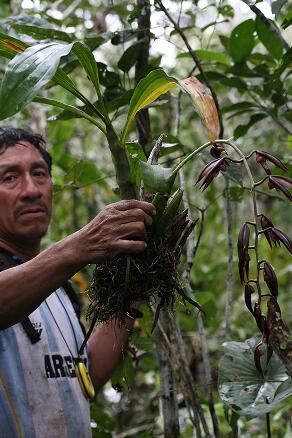Orchidaceae
Catasetum

Kingdom: Plantae Rank: Genus Parent: Orchidaceae Status: Valid
Morphological Description
Diagnosis:
The large pseudobulbs with numerous deciduous leaves can only be confused in the flora with Mormodes. The flowers of most species of Catasetum are dimorphic (C. fernandezii and C. saccatum in this flora) – “female” flowers are non-resupinate and have a large, green, hood-like lip – “male” flowers are resupinate and variable. The pollinia are held under pressure and are forcibly ejected when antenna-like triggers on the column are touched. In constrast, the flowers of Mormodes are asymmetric by twisting of the lip and column and the pollinia are not forcibly ejected.
1 Plants and leaves pendent; leaves less than 3 cm wide. ...
........................................... C. longifolium
1’ Plants and leaves erect; leaves more than 3 cm wide. ... 2
2(1’) Lip unlobed; sepals to 3 cm long. ......... C. fernandezii
2’ Lip 3-lobed; sepals to 6 cm long. ............ C. saccatum
Vegetative Morphology
Habit: Caespitose monoecious sympodial epiphytes, lithophytes or terrestrials. Pseudobulbs spindle-shaped, fibrous, rooting at the base.
Leaves: Leaves several, plicate, distichous, deciduous.
Reproductive Morphology
Inflorescence: Inflorescences erect to pendent basal pedunculate racemes, the floral bracts inconspicuous.
Flowers: Flowers unisexual (usually non-functional when hermaphroditic), dimorphic; the pistillate (“female”) flowers similar throughout the genus, not resupinate, green, with a rigid helmet-like lip; staminate (“male”) flowers highly variable, resupinate or not resupinate, the lip helmet-like to flat, variously lobed and ornamented. Sepals and petals free, spreading, the petals often erect and subparallel with the dorsal sepal. Lip unlobed or three-lobed, saccate, globose to flat, sessile. Column erect, without wings or foot, with a pair of antennae-like triggers, the anther with a terminal beak; pollinia 2, on a common linear stipe and a large viscidium with copious glue.
Other
Notes: A number of sterile Catasetum plants have been observed both east and west of Quillabamba by the author, but no flowering material has been examined from this area. These may prove to be additional populations of the widespread C. saccatum.